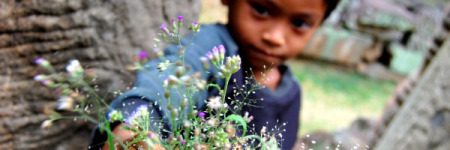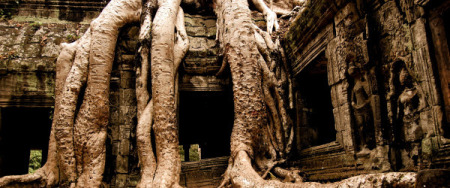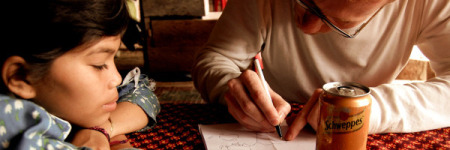Article by BikeToursDirect Asia Tour Specialist Lindsay Nash, originally published on Galavanting.
[caption id="attachment_2542" align="aligncenter" width="450"]

A boy working at the temple hands me a bouquet inside one of the ruins.[/caption]
Across Asia, people ring in the solar New Year not with a sinking sparkling ball but a rising bright orange sun on the first new dawn of the year as it ascends over the horizon as quickly as bygone years.
It was on my recent trip to Southeast Asia that I was afforded the opportunity to bask in this tradition at Angkor Wat, Cambodia, one of the world’s best spots to view a sunrise.
Cambodia is a country that often conjures images of war-torn poverty for many people across the globe, and understandably. It was bombed heavily by the U.S. in the late 1960s and then taken over by Pol Pot’s brutal Khmer Rouge regime in the 1970s, a period of genocide, civil war and oppression. Just in the last decade, the country—still one of the poorest in the world with a 35 percent literacy rate—has reopened its doors to tourism, welcoming tourists and their dollars on their slow road to recovery.

So what lured me to this land of slow-healing heartache?
The promise of a country starting fresh. The raw heartstrings that tells you that there is more to this place than its dusty, bumpy roads, fried spiders and time-ticking landmines.
And of course, Angkor Wat.
I wanted to see these ruins, the remnants of the Angkorian capitals that represent the pinnacle of ancient Khmer architecture, art and civilization. In its glory days, the Age of Angkor was a time when the empire contained more than a million people, when Khmer kings constructed vast waterworks and grand temples, and when the Angkor kingdom held sway over the area of modern Cambodia, and much of Thailand, Vietnam and Laos. The now crumbling Hindu- (and later Buddhist-) inspired temple complex was built in the early 12th century and rediscovered in the jungle in the 1800s by a Frenchman.
My friends, husband, and I were dying to see it. Since we were spending our winter holiday from teaching in Korea in the Mekong Delta area of Vietnam, we decided to spend the last part of our time in Cambodia.
Travel guides abound in Vietnam, and it was as easy as breakfast pho to catch a small boat up the Mekong River and over the border to Cambodia. We walked straight past the men hawking $2 rides in tuk-tuks in the tattered yet charming capital of Phnom Penh and hopped a chartered bus for an all-day trek along two-lane bumpy roads to Siem Reap—home to Angkor Wat.
On one of the very few paved roads in the country, our roomy air-conditioned bus shared an elastic lane with couples darting on smog-belching motorbikes, men driving horse-drawn tractors, women pedaling bicycles, and children running with the freedom only children have across the two-lane road to somewhere else.
Small wooden shacks on stilts dotted the rural roadside and were the bases of a cluster of activity. Chickens pecked on the dusty dirt during dry season. Women sat outside, shucking corn, cutting pineapples, cleaning rice. Men tinkered on old cars driven in a different time. Grandfathers dozed in dirty hammocks. Stray dogs rummaged in the trash. Skinny cows with large bells strolled large pastures.
As dusk settled in to the countryside like lazy eyelids longing to dream, small fires and solitary light bulbs dangling from string illuminated rural life. Some homes had electricity. Many did not. Kitchen pots and pans lay across floors. Hammocks hung from corners. Occasional TVs spotted the bare-floor living rooms.
At the rest stop along the way, young girls sold plastic bags of chopped pineapple and a chance to hold a defanged tarantula.
"Miss. Miss. One dollah," they said in their ragged clothes and big smiles. Women squatted against concrete walls, selling roadside snacks of dried spiders and fried grasshoppers.
The young girls working at the rest stop were the first of many we encountered in Cambodia. Children who were beautiful, smart, English-speaking, quick-witted, and charming. I was immediately enamored. As we pulled away from the rest stop, the girls waved at us with tarantulas in their hands and big smiles on their faces.
It was at Angkor Wat the next day when we were lucky enough to eat lunch with another set of girls selling trinkets on the grounds. Angkor Wat—simply one of the most majestic, astounding man-made creations still in existence—is easily the country’s national treasure, its picture proudly stamped on the Cambodian flag and limitless souvenirs.
But once you go there, once you spend a few days ambling and clamoring through the 37 square miles of colossal lateritic and sandstone rocks known as the largest religious monument ever built, you’ll also soon realize that it’s the children that make the place so special. It’s the children who are the country’s national treasure.

They hawked their tchotchkes at every entrance and exit of the ruins, occasionally sneaking into the temples and surprising you in shadowy corners with a "Miss Miss, postcard? Ten for one dollah.” It was in one such corner when a young barefoot boy jumped out with outstretched hands and a bouquet of freshly plucked weeds. I knew at that moment, I was hopelessly, head-over-heels in love with this country.
At lunch, we sat down with two girls who wanted to sell us a postcard or magnet from their large straw baskets. They spoke nearly-perfect English and could tell us every capital in the world. It was not clear whether they went to school. But, it was easy to see that this centuries-old rock-fallen temple was their classroom; the tourists, their teachers.
America, we quizzed them.
"Washington D.C."
France. "Paris"
Portugal. "Lisbon."
"Where you from?" one girl asked me.
"Tennessee," she wrote in a mysterious Cambodian script in her small tattered notebook that she pulled out of a back pocket. It was a new place to add her to her pages of destinations she’ll probably never see.
"Capital?" she asked. "Nashville," she wrote in her strange curvy script as I sounded it out.
We wanted to further test her knowledge. Who's the president of America?
"Bush."
"Who is the president-elect?" we continued.
"Barack Obama. Bush a bad man but Obama a good man," she said with the wisdom of an old man, or at least one who has voted once or twice. "Vice president. Joe Biden,” she continued, turning her knowledge into a sales pitch. “You want to know secretary of state you buy one postcard.”
Jayavarman VII, king of the Khmer empire during its height of existence, said he built the temples at Angkor Wat “full of deep sympathy for the good of the world, so as to bestow on men the ambrosia of remedies to win them immortality....By virtue of these good works would that I might rescue all those who are struggling in the ocean of existence.”
This country does continue to be rife with poverty, struggling every day to improve its existence. Land mine victims do abound with outstretched pots of jangling change along many dusty street alleys. And the older population—or what’s left of them—dotell their stories of hardship in their eyes.
But a different story is told from their smiles. Ones that creep up every morning with the rising sun despite the clouds. Despite the rain. Despite the storms. Smiles that remind us that as the new dawn emerges, so do they. They might not have much money, or a high literacy rate, or many paved roads. But it’s no secret they have an abundance of riches.
If you can’t see them in the bas-reliefs of Angkor Wat’s Bayon temple, then simply gaze into the shining, smiling faces of the children.
BikeToursDirect's new and growing selection of bike tours in Cambodia
- Angkor Wat Explorer Tour (5-day), guided, $542
- Bangkok to Siem Reap (8 nights), guided, $1788
- Cambodia: Angkor Wat (3 nights), guided, $696
- Charming Cambodia: Angkor Wat to Phnom Penh (12 nights), guided, $1797
- Saigon to Bangkok (Vietnam, Cambodia, & Thailand); 17 nights, guided, $3159
- Saigon to Siem Reap (12 nights); guided, $1906
In addition to these Cambodia bike tours, we now have more than 54 guided and self-guided
bike tours in Asia.
Start searching these offerings now, and feel free to
email me with questions on tours in Asia!
Leave a Comment


 A boy working at the temple hands me a bouquet inside one of the ruins.[/caption]
A boy working at the temple hands me a bouquet inside one of the ruins.[/caption]
